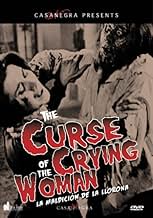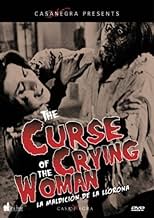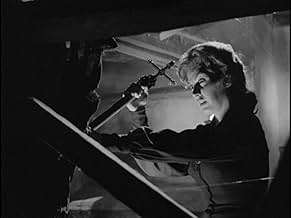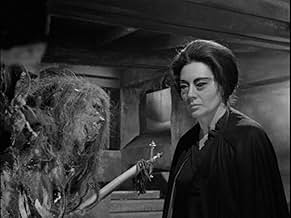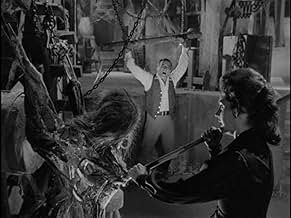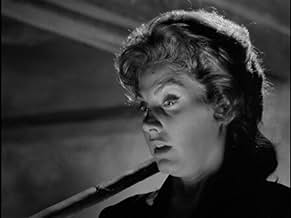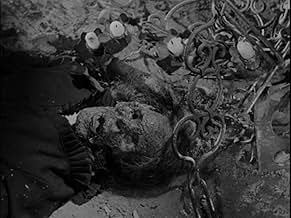IMDb RATING
6.5/10
859
YOUR RATING
After fifteen years of being away, a woman returns with her husband to her aunt's hacienda in the Mexican countryside, without realizing that her relative is a sorceress who wants to use her... Read allAfter fifteen years of being away, a woman returns with her husband to her aunt's hacienda in the Mexican countryside, without realizing that her relative is a sorceress who wants to use her to bring an evil witch back to life.After fifteen years of being away, a woman returns with her husband to her aunt's hacienda in the Mexican countryside, without realizing that her relative is a sorceress who wants to use her to bring an evil witch back to life.
Carlos López Moctezuma
- Juan
- (as Carlos Lopez Moctezuma)
Featured reviews
10rkolesza
I just watched CasaNegra Entertainment's version of this film on DVD, fully restored and all I can is Wow, they did a great job with it. It's such a treat to see these old Mexican classic finally get the attention they deserve. Curse of the Crying Woman is often considered the the Mexican Black Sunday and it lives up to it in every way. Beautifully filmed entirely at night, creepy mist, candle lit dungeons and dead trees are everywhere. These type visual elements were one of the trademarks in many of great horror films from Meixco and definitely what helps make them unique.
The story involves a young woman who upon visiting her Aunt who lives in a creepy Hacienda mansion in the countryside, learns she is next in line to join a family of evil witches. The Mexican title suggests the film is based on the legend of Llorona which it is only loosely. Baledon takes the real legend and morphs it into his own screen play and the outcome is pure classic horror enjoyment. A must for any true lover of Gothic, Black and White horror movies.
The story involves a young woman who upon visiting her Aunt who lives in a creepy Hacienda mansion in the countryside, learns she is next in line to join a family of evil witches. The Mexican title suggests the film is based on the legend of Llorona which it is only loosely. Baledon takes the real legend and morphs it into his own screen play and the outcome is pure classic horror enjoyment. A must for any true lover of Gothic, Black and White horror movies.
"La Maldición De La Llorana" aka. "The Curse of the Crying Woman" (1963) is a haunting and absolutely ingenious little treasure of Mexican Gothic Horror cinema, that simply has to be seen by anybody interested in Horror. In spite of an obviously low budget, director Rafaél Baldedón accomplished to create a film of incredibly eerie atmosphere and genuine creepiness that represents all the great qualities we love in Gothic Horror film. In some parts clearly inspired by Mario Bava's milestone "La Maschera Del Demonio" ("Black Sunday", 1960, which is probably my choice for THE greatest Horror film ever made), "La Maldicion De La Loorana" is a stroke of genius of its own right that mesmerizes like few other films.
"La Llorana" (the 'Crying Woman') is apparently a classic character of Latin-American folk tales, and has been the theme of several other Mexican Horror films; As far as I know, however, the 'Crying Woman' in this film has very little resemblance to the folk story character. The film begins magnificently creepy when the passengers of a stagecoach passengers fall victims to a gruesome encounter. Shortly thereafter, newlyweds Jaime (Abel Ferrara) and his young wife Amelia (Rosa Arenas) come to the area in order to visit Amelia's aunt Selma (Rita Macedo). Amelia notices that her beautiful but mysterious aunt, who lives in an eerie mansion, has not aged a day since she last saw her as a child... "La Maldición De La Llorana" is an absolutely awesome classic Gothic tale of witchcraft, curses and resurrection that simply has everything my fellow fans of Gothic Horror so love about this kind of cinema. Incredibly eerie settings and macabre set-pieces, such as an eerie mansion, dark tombs and secret passages, a captivating score, ingeniously creepy makeup and, not least, a delightfully macabre and haunting story make this an absolute must for every Horror lover to see. This one's budget wasn't high, but director Baledón made the best out of it, and proves once again that it doesn't need a vast sum of money in order to make a film look and feel magnificently creepy. Beautiful Rita Macedo is great and eerie in her role and Rosa Arenas fits greatly in the role of the innocent beauty. Abel Salazar, who plays the husband may be recognized for playing the title role in the wonderfully trashy gem "El Barón Del Terror" (1962) and prolific Mexican actor Carlos López Moctezuma shines in the role of the sinister servant. The film also includes a small appearance of Julissa, who would later star alongside Boris Karloff in some of the Horror deity's very odd last films.
It seems as if my enthusiasm for Mexican Horror films is growing with each film I see, and though I regrettably cannot (yet) claim to be an expert on the field, I can say that, judging by the films I've seen so far, Mexico of the 1960s was a great country for Gothic tales. Though it my have some minor flaws, "La Maldición De La Llorana" is a downright brilliant film that ranges only slightly below the absolute masterpieces of 60s Gothic cinema, such as Antonio Margheriti's "Danza Macabra", Roger Corman's Poe-films with Vincent Price or anything that Mario Bava made. This little masterpiece, as well as the equally brilliant Mexican Goth-Horror gem "Misterios De Ultratumba" ("Mysteries From Beyond The Grave"), is deliciously creepy beyond belief, and an absolute must-see for all Horror fans to see. Very Highly Recommended!
"La Llorana" (the 'Crying Woman') is apparently a classic character of Latin-American folk tales, and has been the theme of several other Mexican Horror films; As far as I know, however, the 'Crying Woman' in this film has very little resemblance to the folk story character. The film begins magnificently creepy when the passengers of a stagecoach passengers fall victims to a gruesome encounter. Shortly thereafter, newlyweds Jaime (Abel Ferrara) and his young wife Amelia (Rosa Arenas) come to the area in order to visit Amelia's aunt Selma (Rita Macedo). Amelia notices that her beautiful but mysterious aunt, who lives in an eerie mansion, has not aged a day since she last saw her as a child... "La Maldición De La Llorana" is an absolutely awesome classic Gothic tale of witchcraft, curses and resurrection that simply has everything my fellow fans of Gothic Horror so love about this kind of cinema. Incredibly eerie settings and macabre set-pieces, such as an eerie mansion, dark tombs and secret passages, a captivating score, ingeniously creepy makeup and, not least, a delightfully macabre and haunting story make this an absolute must for every Horror lover to see. This one's budget wasn't high, but director Baledón made the best out of it, and proves once again that it doesn't need a vast sum of money in order to make a film look and feel magnificently creepy. Beautiful Rita Macedo is great and eerie in her role and Rosa Arenas fits greatly in the role of the innocent beauty. Abel Salazar, who plays the husband may be recognized for playing the title role in the wonderfully trashy gem "El Barón Del Terror" (1962) and prolific Mexican actor Carlos López Moctezuma shines in the role of the sinister servant. The film also includes a small appearance of Julissa, who would later star alongside Boris Karloff in some of the Horror deity's very odd last films.
It seems as if my enthusiasm for Mexican Horror films is growing with each film I see, and though I regrettably cannot (yet) claim to be an expert on the field, I can say that, judging by the films I've seen so far, Mexico of the 1960s was a great country for Gothic tales. Though it my have some minor flaws, "La Maldición De La Llorana" is a downright brilliant film that ranges only slightly below the absolute masterpieces of 60s Gothic cinema, such as Antonio Margheriti's "Danza Macabra", Roger Corman's Poe-films with Vincent Price or anything that Mario Bava made. This little masterpiece, as well as the equally brilliant Mexican Goth-Horror gem "Misterios De Ultratumba" ("Mysteries From Beyond The Grave"), is deliciously creepy beyond belief, and an absolute must-see for all Horror fans to see. Very Highly Recommended!
I almost feel the urge to spontaneously start a Mexican Wave in honor of this SUBLIME Gothic horror movie! When listing the most important classic horror titles and their countries of origin, people automatically think about Italy (with Mario Bava and his "Black Sunday"), Spain (with about a million Paul Naschy films) and naturally Britain (with the legendary Hammer and Amicus production studios). Mexico understandably always gets left out, but it truly deserves to be mentioned too, if it were only for THIS movie alone! "The Curse of the Crying Woman" is nearly flawless Goth-horror and features all the aspects that make the genre fans' mouths water. Filmed in beautiful black & white and bathing in an uncanny atmosphere, this movie is compelling from start to finish and several eerie images will haunt your thoughts even long afterwards. The story is simplistic, yet effectively creepy, the decors & set pieces are overwhelmingly sinister and the make-up effects are surprisingly convincing. No wonder this film often gets compared to Mario Bava's aforementioned milestone "Black Sunday". If you take the wise decision of purchasing "The Curse of the Crying Woman", you may expect to see endless dark forests, old mansions, ominous thunderstorms and of course a sardonic mythical storyline that tightly connects all these elements together. On the night of her 25th birthday, beautiful Amelia and her husband arrive at her aunts' Selma reputedly "cursed" house. Amelia has been looking forward to be reunited with her aunt since years, but she doesn't know that the sole reason of her invite is to serve as the final sacrifice to resurrect an ancient witch. Throughout the years, Selma became obsessed with the powers of Marina; an evil bitch that lures woods-travelers with her cries and kills them. Even if the young couple manages to avoid the curse, they still need to defeat Selma's horribly scarred servant and the mutated monster in the attic. The tension & atmosphere are masterfully built up, especially during the first 45 minutes. Director Raphael Baledón then seems to lose his tight grip on the story a bit around the hour, but he immediately rectifies himself again with an unforgettable climax. The sequence with the chiming bell alone is worth a standing ovation! Mesmerizing horror experience, recommended to fans of the genre all over the world.
* Special word of thanks to loyal IMDb-user G.B, for helping me to obtain this new personal favorite.
* Special word of thanks to loyal IMDb-user G.B, for helping me to obtain this new personal favorite.
While not quite in the same league as THE BLACK PIT OF DR. M (1958) or THE WITCH'S MIRROR (1960), this is yet another fine addition to the great - and largely unheralded - series of classic Mexican horror films. This was actually the fourth of at least five vintage films about the titular creature (in the last of these, she was even pitted against another Mexican legend - Santo the wrestler!): it would be great if the others were revived - no pun intended - as well somewhere along the line by Casanegra or whomever.
Again, the film positively drips with atmosphere and style (belying the miniscule budget on hand) - generally coming off as unmistakably Mexican but also borrowing freely from other horror titles, most notably Mario Bava's seminal BLACK Sunday (1960). As in THE WITCH'S MIRROR - which, incidentally, shared with this film its star Rosita Arenas, producer Abel Salazar (here he essayed the role of the male lead as well) and composer (the ubiquitous Gustavo Cesar Carrion) - weird mirror imagery plays an essential part in the narrative, as does witchcraft, for that matter. The scarred 'monster' of that film as well as THE BLACK PIT OF DR. M, then, is incarnated here not by one but three different figures - The Crying Woman herself, decomposed and awaiting re-animation; her disciple Rita Macedo's hulking and club-footed henchman; and Macedo's once-distinguished husband, whom she has kept locked up for years and who has consequently regressed to a subhuman, animal-like level. Also on hand is a trio of rather skinny-looking Great Danes, which are unleashed from time to time to attack unsuspecting villagers or intruding police officials.
Two of its most compelling sequences are those in which Macedo recounts to Arenas and Salazar (individually) the tale of the "Llorona"; the latter has little real purpose, but its depiction of the events is done through brief snippets of scenes (shown in negative) from other Salazar-produced horror films - I immediately noticed the only shot I'm familiar with up to this point, from THE WITCH'S MIRROR, but shots from THE BRAINIAC (1961; which is next in my Halloween horror marathon!) are included as well, as per the Commentary; besides, here we get an unexpected but effective display of sensuality - which is felt again when Arenas (already in the process of replacing the "Llorona") notices Salazar's bloodied hand. Among the film's indelible images are all the scenes in which the eyes of The Crying Woman's disciples turn completely black - an effect seen in the very first shot and which was later lifted by INVASION OF THE BEE GIRLS (1973); Macedo's bat-like swoop towards the camera and Arenas' hallucination (which is as expressionistic as they come, with the night sky being crammed with staring accusing eyes) are also worth mentioning and striking, too, is the distinctive make-up design for each of the 'monsters'.
The busy climax - in which Salazar and Carlos Lopez Moctezuma (the henchman) engage in a lengthy and energetic fist-fight, and the long-suffering husband Domingo Soler finally gets even with Macedo, as the hacienda collapses around them - is quite splendid. Also notable here is the lighting when the 'possessed' Arenas attempts to liberate the "Llorona" by removing a stake from her body (a scene which, unfortunately, is absurdly over-extended so as to allow the huge bell in the impressive bell-tower set at the top of the mansion - as important to this film as it was to Hitchcock's VERTIGO [1958] - to chime 12 times!). The film features a generous number of effective shock moments and some rather graphic violence for the time: the scene where a girl - played by Macedo's real-life daughter, billed as Julissa del Llano - is trampled by a carriage; one where the pitiful and half-crazed Soler is brutally whipped by the sadistic Moctezuma, until he retaliates (a scene which is heavily reminiscent of Dwight Frye's tormenting of Boris Karloff in James Whale's FRANKENSTEIN [1931]); and especially the dogs' vicious attack on the two constables (sections of which were reportedly trimmed for export versions).
Regrettably, the Audio Commentary for this release turned out to be a major disappointment: not only is there a great deal of dead air on this track, with Michael Liuzza (Casanegra's Vice President, no less!) allowing several of the best scenes to go without comment but, when he does speak, he mainly resorts to biographical details of the various personnel involved!!
Again, the film positively drips with atmosphere and style (belying the miniscule budget on hand) - generally coming off as unmistakably Mexican but also borrowing freely from other horror titles, most notably Mario Bava's seminal BLACK Sunday (1960). As in THE WITCH'S MIRROR - which, incidentally, shared with this film its star Rosita Arenas, producer Abel Salazar (here he essayed the role of the male lead as well) and composer (the ubiquitous Gustavo Cesar Carrion) - weird mirror imagery plays an essential part in the narrative, as does witchcraft, for that matter. The scarred 'monster' of that film as well as THE BLACK PIT OF DR. M, then, is incarnated here not by one but three different figures - The Crying Woman herself, decomposed and awaiting re-animation; her disciple Rita Macedo's hulking and club-footed henchman; and Macedo's once-distinguished husband, whom she has kept locked up for years and who has consequently regressed to a subhuman, animal-like level. Also on hand is a trio of rather skinny-looking Great Danes, which are unleashed from time to time to attack unsuspecting villagers or intruding police officials.
Two of its most compelling sequences are those in which Macedo recounts to Arenas and Salazar (individually) the tale of the "Llorona"; the latter has little real purpose, but its depiction of the events is done through brief snippets of scenes (shown in negative) from other Salazar-produced horror films - I immediately noticed the only shot I'm familiar with up to this point, from THE WITCH'S MIRROR, but shots from THE BRAINIAC (1961; which is next in my Halloween horror marathon!) are included as well, as per the Commentary; besides, here we get an unexpected but effective display of sensuality - which is felt again when Arenas (already in the process of replacing the "Llorona") notices Salazar's bloodied hand. Among the film's indelible images are all the scenes in which the eyes of The Crying Woman's disciples turn completely black - an effect seen in the very first shot and which was later lifted by INVASION OF THE BEE GIRLS (1973); Macedo's bat-like swoop towards the camera and Arenas' hallucination (which is as expressionistic as they come, with the night sky being crammed with staring accusing eyes) are also worth mentioning and striking, too, is the distinctive make-up design for each of the 'monsters'.
The busy climax - in which Salazar and Carlos Lopez Moctezuma (the henchman) engage in a lengthy and energetic fist-fight, and the long-suffering husband Domingo Soler finally gets even with Macedo, as the hacienda collapses around them - is quite splendid. Also notable here is the lighting when the 'possessed' Arenas attempts to liberate the "Llorona" by removing a stake from her body (a scene which, unfortunately, is absurdly over-extended so as to allow the huge bell in the impressive bell-tower set at the top of the mansion - as important to this film as it was to Hitchcock's VERTIGO [1958] - to chime 12 times!). The film features a generous number of effective shock moments and some rather graphic violence for the time: the scene where a girl - played by Macedo's real-life daughter, billed as Julissa del Llano - is trampled by a carriage; one where the pitiful and half-crazed Soler is brutally whipped by the sadistic Moctezuma, until he retaliates (a scene which is heavily reminiscent of Dwight Frye's tormenting of Boris Karloff in James Whale's FRANKENSTEIN [1931]); and especially the dogs' vicious attack on the two constables (sections of which were reportedly trimmed for export versions).
Regrettably, the Audio Commentary for this release turned out to be a major disappointment: not only is there a great deal of dead air on this track, with Michael Liuzza (Casanegra's Vice President, no less!) allowing several of the best scenes to go without comment but, when he does speak, he mainly resorts to biographical details of the various personnel involved!!
Curse of the Crying Woman, The (1963)
** (out of 4)
Another Mexican horror film but this one here really didn't do much for me. A young woman and her husband are invited to a castle by the girl's aunt but the aunt is wanting her help in bringing back the title character. This film runs just over 75-minutes and I could have sworn it was 75-hours. The movie goes very slowly and it never really captured me and pulled me into the thing. The opening sequence didn't work for me and the mystery behind the title character never got me interested either. The camera-work was nice and the visuals were good but that's about it.
** (out of 4)
Another Mexican horror film but this one here really didn't do much for me. A young woman and her husband are invited to a castle by the girl's aunt but the aunt is wanting her help in bringing back the title character. This film runs just over 75-minutes and I could have sworn it was 75-hours. The movie goes very slowly and it never really captured me and pulled me into the thing. The opening sequence didn't work for me and the mystery behind the title character never got me interested either. The camera-work was nice and the visuals were good but that's about it.
Did you know
- TriviaThere have been many film adaptations of the legend, including a 1933 version that is believed to be the first Mexican horror film.
- ConnectionsEdited from Le baron de la terreur (1962)
- How long is The Curse of the Crying Woman?Powered by Alexa
Details
- Release date
- Country of origin
- Language
- Also known as
- The Curse of the Crying Woman
- Filming locations
- Production company
- See more company credits at IMDbPro
- Runtime1 hour 20 minutes
- Color
- Aspect ratio
- 1.37 : 1
Contribute to this page
Suggest an edit or add missing content

